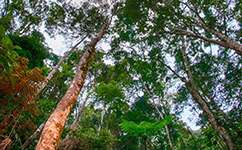Rainforest carbon recovers faster than biodiversity

When tropical forests are cleared, they can take a century or more to re-absorb the carbon they once held, according to a new study. But their biodiversity is even slower to recover, and some species may never return.
Forests absorb carbon from the atmosphere as they grow, but when they are cleared this returns to the atmosphere, contributing to climate change. More than half the world's tropical rainforest has now been cleared for agriculture, logged or burned, so it's important to know how long it takes for so-called "secondary forests" to absorb a similar amount of carbon again once they are allowed to grow back.
"Secondary forest has value from a carbon sequestration perspective, but much less value in conservation terms," says Philip Martin, a PhD student at the Centre for Ecology & Hydrology and lead author of the paper, which appears in Proceedings of the Royal Society B. "We need to look for new ways of increasing biodiversity in a world of fragmented tropical forests."
Martin and his co-authors analysed 74 studies at more than 600 locations throughout the tropics. Their results show that even after about 80 years, a secondary forest's total carbon content is only around 80 per cent of that of primary forest. Biomass above ground is about the same as pre-clearance levels by this point, but biomass in roots below ground is still considerably lower; after 80 years it's still around half its former levels. The researchers think it could take as long as 200 years for the regenerating forest to reach parity with primary forest.
A forest's biodiversity recovers even more slowly than its carbon content. The number of tree species present seems to reach its previous level after about half a century, but other plants such as epiphytes - those that grow on trees - are much slower to return. The authors estimate it could take 150 years or even longer for biodiversity to become comparable to that in primary forest. On average, the secondary forests had only a quarter of those species present in the primary forest.
It may even be that biodiversity will never recover over any timescale that matters to us. These plants have very specialised habitat needs, and find it difficult to jump over stretches of cleared land. Secondary forests are often isolated by farmland all around, so the seeds of old-growth specialist species may never get there.
From both carbon and biodiversity perspectives, the best idea would be to protect primary rainforest so it doesn't get cut down in the first place. But if people do clear it, Martin says there may be ways to increase the number of plants and animals living in the secondary forest that grows back in its place, which usually forms a dense canopy of young, thin trees and so isn't a hospitable environment for young seedlings.
In some cases raising forest species elsewhere then planting them in the secondary forest may help; another option could be to plant small stands of forest trees within farmland to act as stepping stones for birds and other animals to move between tracts of woodland, bringing seeds and fruit with them that might allow plant species to stage a comeback.
"We have to recognise that people use these landscapes, and there's no way we can just clear all the farmland and re-plant it with forest,' Martin says. 'But we may be able to make changes in the landscape that help increase the conservation value of the bits of forest that are left."
Journal information: Proceedings of the Royal Society B
Provided by PlanetEarth Online
This story is republished courtesy of Planet Earth online, a free, companion website to the award-winning magazine Planet Earth published and funded by the Natural Environment Research Council (NERC).

















